Hybrid Work Schedule Best Practices and Types

Hybrid work schedules are paramount in fostering a flexible and adaptive work environment.
The hybrid model integrates the benefits of both in-office and remote work, empowering employees with autonomy over their workspaces and schedules.
It enhances productivity and promotes a healthier work-life balance, allowing individuals to navigate personal and professional responsibilities seamlessly.
The importance of hybrid work schedules extends beyond convenience, influencing employee satisfaction, engagement, and overall well-being.
Top three issues that hybrid work resolves for small businesses are:
1. Cost Efficiency
Managing overhead costs is often a significant challenge for small businesses.
Hybrid work schedules offer a solution by reducing office space, utilities, and other facilities expenses.
This model allows organizations to optimize resources effectively, directing financial resources toward essential business needs.
2. Talent Acquisition and Retention
Small businesses can tap into skilled professionals regardless of geographical constraints, fostering diversity and strengthening their teams.
Additionally, the flexibility of mixed schedules contributes to higher employee retention rates, as individuals appreciate the autonomy and work-life balance.
3. Operational Agility
Hybrid work schedules provide the agility needed to navigate unforeseen circumstances, such as changes in market dynamics or disruptions.
This flexibility enables small enterprises to maintain continuity and respond promptly to evolving business landscapes.
Try Buddy Punch For Free
What is a Hybrid Work Schedule?

A hybrid work schedule is a strategic approach to organizing work that combines in-person and remote elements.
It allows employees the flexibility to work from home on specific days while collaborating in the office when needed.
Hybrid work schedules come in various types, such as office-centric, remote-first, flexible, and fixed models, each tailored to meet organizational requirements.
The goal is to optimize employee productivity, foster a positive work culture, and reduce operational costs by providing a dynamic framework that aligns with the preferences of both employees and employers.
What’s Behind The Hybrid Work Trend?
The driving forces behind this “hybrid work schedule” trend are fostering a work environment that enhances overall company culture and encourages innovative productivity.
One notable aspect is the emphasis on environmental sustainability.
By reducing employees’ need to commute, companies can significantly lower their carbon footprint, aligning with global efforts to combat climate change.
Remote work, a pivotal component of the hybrid model, allows employees to reclaim valuable time previously spent commuting, enabling a better work-life balance.
To fully grasp the significance of this trend, businesses must invest in the necessary training and tools for effective management of remote teams, ensuring a successful transition into the digital transformation era.
What Is A Good Hybrid Work Schedule?
Considering various factors such as work nature, business goals, and individual preferences, organizations can tailor hybrid schedules to optimize results.
For instance, popular models like the “Three days onsite, two days remote (3/2)” balance collaboration and autonomy.
Alternatively, the “Remote-first” approach emphasizes the benefits of working from home.
The key lies in aligning the schedule with organizational objectives, employee preferences, and technological capabilities.
By embracing a well-structured hybrid work schedule, companies can foster better work-life balance, heightened flexibility, and increased job satisfaction, ultimately reducing turnover rates.
Top 5 Types of Hybrid Work Schedules
Following are the top five types of hybrid work schedules.
1. Split Schedule
Split Schedule approach entails employees spending a designated number of days each week working in the office and the remainder working remotely.
The split, such as a 3/2 arrangement with three days in the office and two days remote, offers predictability for both employees and companies.
This structure allows practical work planning around the established schedule, clarifying office space utilization and desk availability.
The Split Schedule addresses the need for in-person collaboration while embracing the flexibility of remote work, striking a balance that fosters productivity and accommodates individual preferences within the hybrid work framework.
2. Team-Driven/Bottom-Up
In this Team-Driven/Bottom-Up arrangement, teams hold the reins in determining their in-office and remote workdays, aligning with their unique collaboration needs.
Some teams may opt for increased face-to-face interaction, choosing more office days, while others may lean towards more remote work for focused tasks.
The flexibility empowers teams to structure their work in a way that suits their dynamics, fostering autonomy and satisfaction.
However, effective cross-functional planning is crucial to synchronizing diverse teams and ensuring a harmonious balance between onsite and remote work.
3. Company-Driven/Top-Down
The Company-Driven/Top-Down model emerges as a structured approach where organizational leadership takes the reins in determining when employees should be in the office or working remotely.
This top-down strategy provides a unified schedule for the entire company or specific teams, offering simplicity in planning and predictability.
While it streamlines overall coordination and fosters a sense of routine, there is a potential drawback.
This rigid approach may not cater to the diverse needs of individual teams or employees who could benefit from more personalized schedules.
Striking a balance between centralized control and team-specific flexibility is crucial for successfully implementing the Company-Driven/Top-Down hybrid work schedule.
4. Staggered Schedules/Shifts
This type of schedule not only considers where employees work but also when.
Companies employing staggered schedules enable employees to be onsite for a portion of the day while working remotely for the remainder.
This nuanced arrangement demands meticulous planning but offers the advantage of collaborative time during core hours and flexibility for employees to tailor their workday.
Common in fields like healthcare and education, this model highlights the adaptability of hybrid work schedules to cater to diverse industry needs, promoting productivity and a balanced work-life dynamic.
5. Total Flexibility
In this pandemic-driven era, fostering a hybrid workplace is pivotal in addressing burnout and enhancing employee well-being.
The perk of Total Flexibility allows individuals to choose when, where, and how they work – be it fully remote, on specific days of the week, or a mix of office and remote days.
This adaptive approach accommodates diverse talent pools and encourages asynchronous collaboration, promoting creativity and brainstorming beyond traditional office time constraints.
Asynchronous messaging and onboarding become integral in a hybrid work policy, ensuring seamless communication for both full-time and part-time employees.
Embracing a future of work that acknowledges individual preferences, this hybrid workweek redefines the office schedule, offering the freedom to personalize the work environment while maintaining a sense of community on Thursdays, the designated office day.
The types of hybrid schedules vary, reflecting the evolving landscape of flexible work arrangements and shaping the future of the hybrid workplace.
Ready to give Buddy Punch a try?
For free trial, no credit card required.
What Is The Best Solution For Managing Hybrid Work Schedules?
In hybrid work schedules, finding the best solution is paramount.
Like the 3:2 model, Cohort schedules establish structured onsite and remote days, fostering clarity and routine.
Alternatively, flexible schedules empower employees to choose their work location and hours, promoting autonomy.
Staggered schedules, suitable for shift-oriented industries, enhance operational efficiency.
To ensure a seamless hybrid environment, embracing clear KPIs, fostering transparent communication, promoting accountability, and investing in the right tools emerge as critical practices.
Buddy Punch | A Top-Notch Solution to Your Hybrid Work Schedule Needs
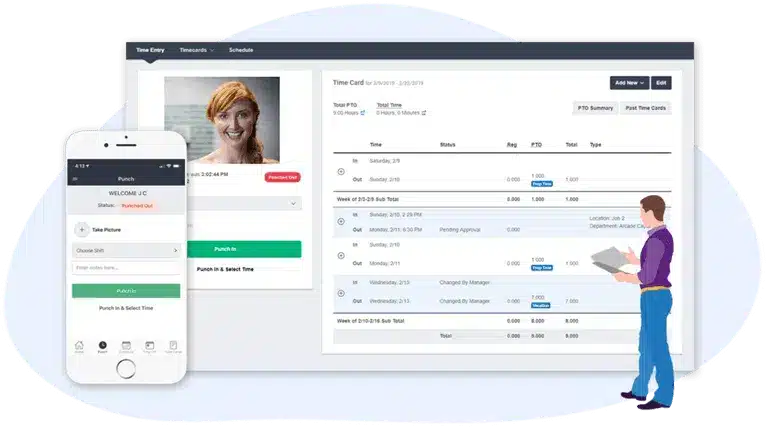
Buddy Punch emerges as a top-notch solution for managing hybrid work schedules, catering to businesses of all sizes across diverse industries such as construction, medical, schools, office staff, and SMBs.
This employee time clock software and app simplifies the complexities of hybrid work arrangements by offering comprehensive features that streamline employee scheduling, time tracking, and payroll management.
Businesses in the construction industry benefit from Buddy Punch’s geofencing and IP address-locking tools, ensuring that remote workers are accounted for, and timekeeping remains optimized.
In the medical field, where precise scheduling and tracking are crucial, Buddy Punch facilitates efficient oversight through image and GPS tracking, ensuring accurate job costing and preventing time theft.
Schools and educational institutions find Buddy Punch invaluable for managing faculty and staff schedules, helping ensure everyone is where they need to be, whether onsite or working remotely.
For office staff and SMBs, Buddy Punch’s user-friendly interface simplifies time tracking, and its robust reporting system aids in payroll calculations, offering a seamless integration with various payroll software solutions like QuickBooks, Paychex, Workday, and ADP.
Compared to manual time-tracking solutions, Buddy Punch excels in automating time and attendance processes, reducing errors, and saving valuable time.
1. Track Real-Time
With Buddy Punch’s intuitive time card app, businesses can effortlessly stay on top of attendance, monitor time-offs, and track overtime, providing employers with crucial insights into their workforce’s daily activities.
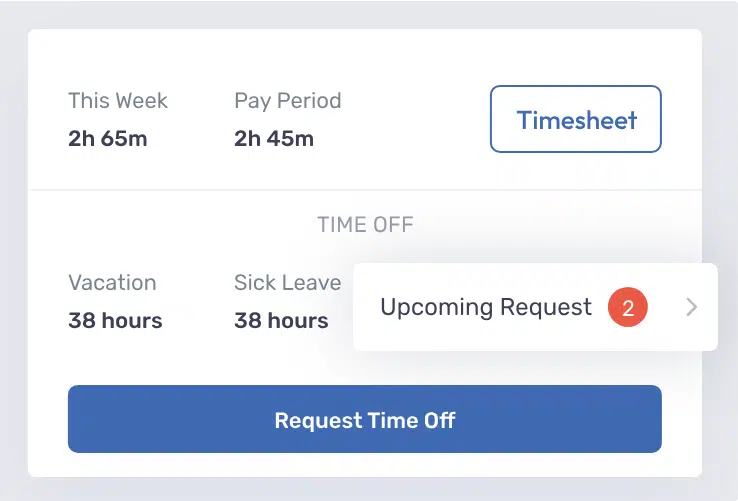
Buddy Punch employs innovative tools like GPS and webcam images to ensure real-time accountability.
Employers can stay informed about their team’s work locations, making it particularly beneficial for remote employees or those working in different job sites.
This real-time tracking feature ensures transparency and helps prevent time theft or unauthorized work activities.
The system also provides flexibility, allowing employees to request paid or unpaid time-offs quickly through a built-in calendar.
2. Accountability
One standout aspect of Buddy Punch is its unwavering commitment to accountability.
The platform employs cutting-edge technology, including GPS and webcam functionalities, to meticulously track employees’ work locations during clock-in and out events.
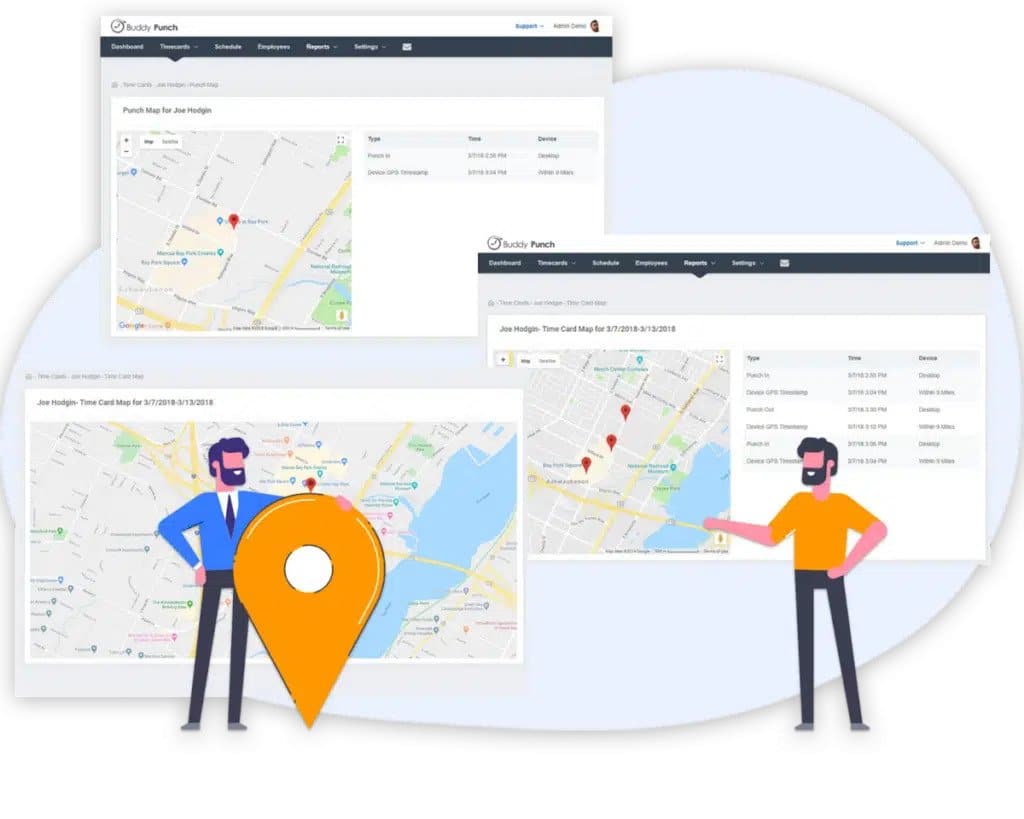
This feature provides employers with real-time insights into the physical whereabouts of their workforce, bolstering trust and transparency in remote and onsite scenarios.
By integrating GPS data and webcam images with each clock event, Buddy Punch ensures employers have a bird’s eye view of employees’ activities.
This prevents time theft and adds an extra layer of security and validation to the time-tracking process.
The accountability aspect goes beyond traditional methods, making it an invaluable tool for businesses with diverse work settings.
Whether employees work from home, at different job sites, or on the move, Buddy Punch’s GPS and webcam tracking feature instills confidence in employers, assuring them that work hours are accurately recorded.
3. Flexible Punch Options
Flexible Punch Options on Buddy Punch go beyond the conventional time clock methods. It empowers employees with multiple choices, allowing customization with a 4-digit PIN, QR codes, facial recognition, or a traditional username/password setup.

This adaptability ensures businesses can seamlessly integrate Buddy Punch into their existing workflow while providing employees with a personalized time-tracking experience.
The 4-digit PIN option offers a quick and straightforward way for employees to punch in and out.
For those inclined towards modern technology, the QR code functionality enables a swift process via webcam scanning on various devices.
The facial recognition feature adds a layer of security and convenience, ensuring accurate time tracking linked to individual identities.
Meanwhile, the traditional username/password method provides a familiar option for those who prefer the classic approach.
By accommodating a spectrum of preferences, Buddy Punch simplifies the time-tracking process and promotes a user-friendly experience.
4. Locations
The Locations feature in Buddy Punch empowers businesses to create designated areas for employees to clock in and out.

Leveraging GPS technology, this feature ensures that employees are precisely where they need to be during working hours.
Whether an organization has diverse office locations or field-based job sites, Buddy Punch’s Locations feature provides unparalleled control over employee clock-ins.
For businesses aiming to streamline operations, the ability to create and assign multiple locations is a game-changer.
When punching in, employees can effortlessly select their specific work location for a given shift.
This data reflects on individual time cards and comprehensive reports, offering transparency and accountability.
This feature aligns seamlessly with the core tenets of hybrid work, promoting flexibility while maintaining a structured approach.
It ensures that employees are accountable for their physical presence when and where needed.
5. Reports
The Reports feature within Buddy Punch is designed to meet diverse business needs by providing customizable reports.
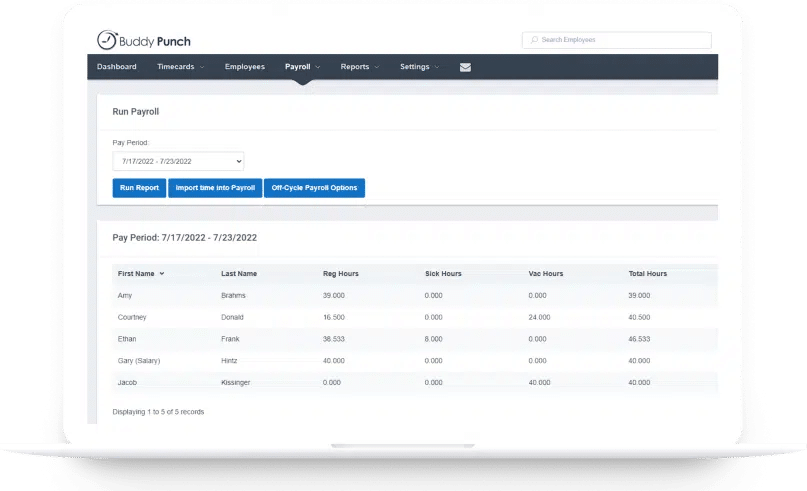
These reports can be tailored to specific requirements and are available in user-friendly formats such as Excel, CSV, and PDF.
This functionality allows businesses to gain valuable insights into employee activities, streamline payroll processes, and enhance project management.
6. Webcam
The Webcam Photo on Punch feature is a cutting-edge tool designed to enhance security and accountability.
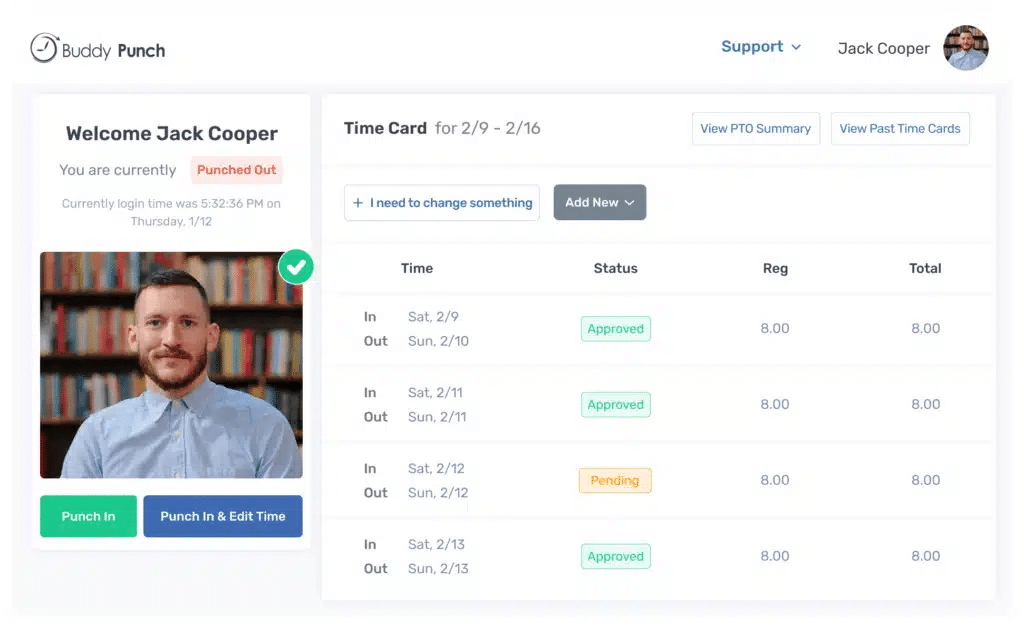
This functionality automatically captures an employee’s picture during clock in and out as a robust deterrent against buddy punching – the practice of one employee clocking in or out on behalf of another.
7. Automatic Breaks
Buddy Punch offers a cutting-edge solution with its Automatic Breaks feature.
This innovative tool streamlines break management by automatically deducting break times according to customizable rules.
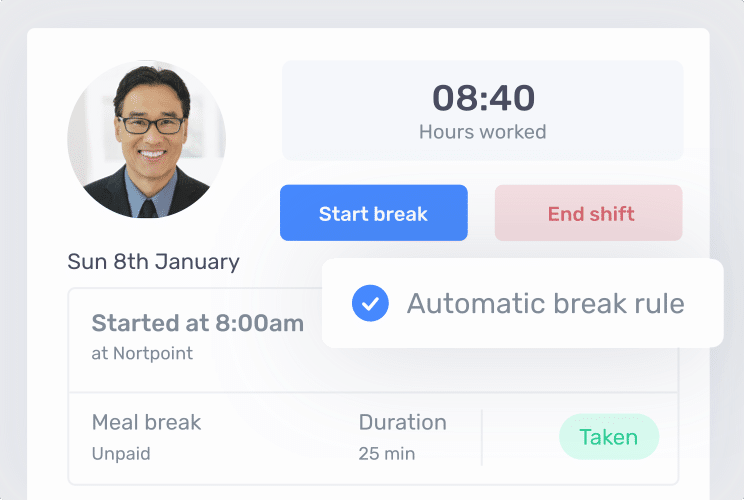
By naming and specifying break triggers, employers can ensure accurate tracking of employee breaks.
This feature not only promotes accountability but also simplifies workforce management.
Forget the hassle of manual adjustments—Buddy Punch takes charge, allowing administrators and managers to focus on other vital aspects of their business.
Whether it’s lunch breaks, short pauses, or different intervals, the Automatic Breaks feature enhances flexibility and precision, ultimately contributing to a seamless hybrid work experience.
8. Integrations
Under the Integrations feature, Buddy Punch seamlessly collaborates with prominent platforms, such as QuickBooks, Paychex, and ADP, ensuring a smooth integration process.

This capability allows businesses to streamline their payroll, and accounting tasks effortlessly.
The software’s versatility extends beyond mere time tracking, offering a comprehensive overhaul of project management.
By effortlessly connecting with these renowned platforms, Buddy Punch simplifies administrative tasks and contributes to increased productivity and strategic focus.
Embrace the future of hybrid work with Buddy Punch, where integration catalyzes a more streamlined and effective work environment.
Buddy Punch’s Online Reviews

“Delighted! As a trucking company and having resources starting their shifts at different times and in different locations it was “effort” in tying this all together to ensure everyone was being paid for correct times – doing payroll was a chore in calling and requesting and then finally imposing deadlines or you don’t get paid which pushes other things back in processing payroll… Week one of deployment -> all those issues disappeared!!! Well done Buddy Punch!!!!”
Click here to read the full review.
“Buddy Punch has been my main source for time tracking since I started my new position. It is user friendly!”
Click here to read the full review.
“The ease of clocking in and out, where ever I may need to punch in. I like that employees are able to make an adjustment to their time and then it gets approved by manager. Which is much easier than having to make punches and delete punches.”
Click here to read the full review.
Try Buddy Punch for Free
Ready to start a free trial?
No credit card required, all features included.
If you feel that Buddy Punch might be the right fit for your business, sign up for a 14 day free trial (no credit card needed). You can also book a one-on-one demo, or view a pre-recorded demo video.
How Do Hybrid Work Schedules Benefit Employees?
Hybrid work schedules have emerged as a transformative approach, offering significant advantages to employees.
1. Improved Work-Life Balance
Hybrid models allow employees to design their workday around personal obligations and preferences.
This newfound autonomy will enable individuals to achieve a more harmonious integration of professional and personal life.
Employees can choose when and where they work by eliminating the constraints of a fixed 9-to-5 schedule, fostering a sense of control over their time.
This flexibility translates into several advantages.

Employees experience reduced stress levels as they can adapt their work hours to align with their peak productivity periods.
Commuting time becomes obsolete, giving individuals more time for personal well-being, family, and leisure activities.
Consequently, improved work-life balance enhances job satisfaction, increases overall happiness, and positively impacts mental health.
2. More Individual Control
Unlike traditional office setups, hybrid models allow individuals to choose when and where they work.
This increased control enables employees to align their work with their most productive hours, fostering a personalized approach to task management.
With the ability to structure their workday around personal preferences, employees experience a significant reduction in commuting-related stress and time.
3. Boost Flexibility And Employee Satisfaction
By embracing hybrid models, organizations empower employees with the flexibility to balance professional and personal commitments effectively.
The boost in flexibility not only accommodates diverse working styles but also significantly contributes to heightened employee satisfaction.
This, in turn, enhances overall job contentment, reduces stress associated with rigid schedules, and supports a healthier work-life balance.
4. Reduce Costs
Embracing a hybrid model allows employees to spend fewer days commuting, leading to substantial cost savings for individuals and organizations.
Employees can reduce transportation expenses, saving money on fuel, public transit, or vehicle maintenance.
Reducing the need for office space, utilities, and other overhead costs is significant for employers.
With fewer employees in the physical office on any given day, businesses can optimize their space and allocate resources more efficiently.
5. More Work Location Options
Hybrid models empower individuals to choose where they work, breaking free from the confines of a traditional office setup.
With the freedom to alternate between home, coworking spaces, or satellite offices, employees can create a conducive setting that enhances productivity and well-being.
The ability to select different work locations accommodates diverse workstyles and fosters a healthier work-life balance.
6. Increased Personal Savings
With the reduction in daily commuting expenses, such as fuel and public transportation fees, employees experience a tangible increase in personal savings.
The flexibility inherent in hybrid work models allows individuals to curtail commuting frequency, translating into fewer expenses related to travel.
Moreover, the shift to a hybrid work setup can reduce expenses associated with work attire, lunches, and other incidental costs linked to a traditional office setting.
As employees gain greater control over their work environment and spend less time commuting, they save money and enjoy an improved work-life balance.
7. Better Mental Health And Reduced Stress
By avoiding the daily grind of commuting and gaining autonomy over their workspace, employees experience a significant reduction in stress levels.
The ability to structure their workday around peak productivity hours, whether early morning or late evening, contributes to a more harmonious work-life balance.
Studies consistently link remote and hybrid work setups to increased job satisfaction and lower stress levels.
8. Improved Employee Engagement
The flexibility in hybrid models allows employees to choose between remote and in-office work and fosters a sense of autonomy and control.
This autonomy directly impacts employee engagement, as individuals feel empowered to structure their work in a way that suits their preferences and enhances productivity.
With the ability to create a personalized work environment, employees are more likely to feel invested in their tasks and connected to the organization’s goals.
Additionally, the reduced stress associated with commuting and the freedom to manage one’s schedule contributes to higher job satisfaction and increased engagement.
By prioritizing individual needs and preferences, hybrid work schedules create a conducive atmosphere for employees to actively participate, collaborate, and feel more engaged in their roles.
9. Increased Productivity
Eliminating daily commutes allows individuals to reclaim valuable time, which can be redirected toward work-related tasks.

Hybrid work models empower employees to structure their workdays in alignment with their peak productivity hours, fostering a more efficient and focused work approach.
Moreover, the reduction of workplace distractions and the ability to create a personalized, comfortable workspace contribute to heightened concentration and output.
As a result, employees often achieve more in less time, elevating overall productivity levels.
Key Challenges of Implementing a Hybrid Work Schedule
The following are the key challenges of implementing a hybrid work schedule.
1. Bias Toward In-Office Employees
While hybrid models aim to provide flexibility, there’s a risk of unintentional bias toward those who opt for in-office work.
This bias can manifest in various forms, such as favoritism in project allocations or decisions made during in-person meetings.
To address this challenge, organizations must establish clear communication channels and equal opportunities for both in-office and remote team members.
Leadership should actively promote an inclusive culture that values contributions, regardless of physical work locations.
Implementing transparent policies and leveraging collaboration tools can help mitigate bias, ensuring that all employees feel equally valued and included in the decision-making process regardless of their chosen work setting.
2. More Coordination Issues
The shift to a hybrid model introduces complexities related to coordinating schedules and ensuring seamless collaboration among team members.
Effective coordination becomes crucial for maintaining productivity and project timelines with employees working from various locations, time zones, and possibly different days in the office.
Organizations should invest in robust communication and project management tools to overcome this challenge.
Implementing a shared calendar system, conducting regular virtual check-ins, and establishing standardized communication protocols can enhance coordination.
Also, fostering an evident communication culture and setting expectations around response times can contribute to smoother collaboration despite the dispersed nature of hybrid work.
3. Difficulty With Culture Building
Building and maintaining a cohesive company culture becomes more challenging when employees work from diverse locations.
To address this hurdle, companies should proactively focus on fostering a robust virtual culture.
This involves organizing virtual team-building activities, creating digital spaces for casual interactions, and promoting open communication channels.

By leveraging technology and encouraging inclusivity in remote interactions, organizations can bridge the gap and ensure that the essence of their culture remains intact.
4. Not Suitable For All Industries
Jobs requiring a physical presence, hands-on work, or specific equipment may find accommodating remote or flexible arrangements challenging.
Industries such as manufacturing, healthcare, and retail, where on-site operations are integral, might need help embracing hybrid work schedules.
Overcoming this challenge involves a thoughtful evaluation of job requirements and the development of alternative strategies, such as staggered schedules or hybrid models tailored to the unique demands of each industry.
5. Difficulty In Standardizing Productivity Checks
The traditional office setup often relies on observable cues for measuring productivity, such as office hours and face-to-face interactions.
However, standardizing productivity assessments becomes complex in a hybrid model where employees work from various locations.
Establishing uniform metrics to gauge productivity across diverse work settings proves challenging.
Supervisors may need help to implement consistent evaluation methods that consider the unique dynamics of remote and in-office work.
Overcoming this challenge involves adopting technology-driven tools, clear communication on performance expectations, and shifting towards outcome-based assessments rather than time-centric measures.
Navigating this difficulty ensures a fair and practical approach to evaluating employee performance in the context of hybrid work schedules.
6. Security Concerns
With employees accessing company systems from various locations, the risk of data breaches and unauthorized access increases.
Ensuring the security of sensitive information becomes paramount in this dynamic work environment.
Organizations must invest in robust cybersecurity measures, including encrypted communication channels, secure virtual private networks (VPNs), and multifactor authentication.
Educating employees about the importance of adhering to security protocols, such as regularly updating passwords and being vigilant against phishing attempts, is essential.
What Are The Best Practices Of Hybrid Work Schedules?
The following are some of the best practices of implementing a hybrid work schedule.
1. Coordinate Time In The Office
Efficiently managing employees’ time in the office fosters collaboration, enhances team dynamics, and promotes a sense of belonging.
Organizations should establish clear communication channels to implement this practice effectively for scheduling in-office days.

Utilizing collaborative tools and shared calendars helps streamline the coordination process, allowing teams to align their schedules seamlessly. Just don’t be afraid to occasionally look into alternatives and upgrades for your favorite tools.
Additionally, flexibility in choosing in-office days accommodates individual preferences and enhances overall employee satisfaction.
2. Create A Culture Of Transparency And Trust
Creating a culture of transparency and trust is paramount when implementing a hybrid work schedule.
This practice is the cornerstone of successful remote collaboration and employee satisfaction.
By fostering open communication and sharing information transparently, organizations build trust among team members.
To implement this practice effectively, companies should leverage digital communication tools, conduct regular check-ins, and encourage an inclusive environment where employees feel comfortable expressing their opinions.
Transparent policies regarding expectations, goals, and performance metrics contribute to a shared understanding among team members.
In a hybrid work setting, trust becomes the glue that holds teams together, regardless of physical location.
3. Allow Time For Focus
Employees often navigate between in-office and remote work environments in a mixed setting.
To optimize productivity, it’s essential to carve out periods during which distractions are minimized, promoting deep work and concentration.
Encourage employees to schedule “focus time” in their calendars, signaling to colleagues that they should avoid unnecessary interruptions during these periods.

This practice recognizes the importance of uninterrupted work for tasks that demand concentration.
Additionally, organizations can provide guidelines on effective time management, helping employees balance collaborative activities and focused, individual work.
4. Use The Right Tools For Hybrid Work
Invest in collaborative platforms, project management tools, scheduling software, and video conferencing software to facilitate seamless communication and coordination.
Cloud-based applications enable real-time collaboration and document sharing, fostering teamwork regardless of physical location.
Video conferencing tools bridge the gap between in-person and virtual interactions, enhancing face-to-face communication.
Additionally, project management software aids in tracking tasks and maintaining transparency in work progress.
5. Set Clear Rules And Policies
Establishing clear rules and policies is a fundamental best practice in implementing a successful hybrid work schedule.
Clarity in expectations helps create a structured work environment, ensuring that both in-office and remote employees understand their roles and responsibilities.
Clearly defined guidelines regarding working hours, communication protocols, and project deadlines contribute to a harmonious and productive work culture.
Organizations promote consistency and fairness by setting transparent rules and reducing employee ambiguity.
This clarity aids in maintaining accountability and aligning individual and team goals with organizational objectives.
Additionally, well-communicated policies foster a sense of trust among team members, regardless of their physical work locations.
6. Document Hybrid Work Schedule Guidelines
By clearly outlining expectations, policies, and procedures, organizations can provide employees with a comprehensive understanding of how hybrid work operates.
These documented guidelines should cover various aspects, including working hours, communication protocols, collaboration tools, and performance expectations.
Clearly defined guidelines help maintain consistency across the workforce, fostering a sense of fairness and equality among both in-office and remote team members.
Moreover, having a documented framework serves as a reference point for employees, promoting transparency and reducing ambiguity.
It aids in addressing common queries, concerns, and challenges that may arise in a hybrid work environment.
7. Create A Friendly Workplace Culture
In a hybrid setting, where teams may be physically distant, cultivating a sense of camaraderie is essential.
Encourage open communication, both virtually and in-person, and facilitate team-building activities that bridge the gap between remote and in-office employees.
Leadership plays a pivotal role in setting the tone for a friendly culture.
Emphasize the importance of respect, appreciation, and support for individual differences.

By prioritizing a friendly workplace culture, organizations can enhance team cohesion, boost morale, and contribute to the overall success of hybrid work arrangements.
A positive culture attracts and retains talent and contributes to a more productive and satisfying work experience for employees.
8. Consider Employees’ Needs
Recognizing that each employee has unique preferences and requirements is crucial for building a flexible and supportive work environment.
Initiate regular surveys or feedback sessions to understand your workforce’s preferences regarding remote and in-office work.
Tailor the hybrid schedule to accommodate various work styles, personal circumstances, and preferred collaboration methods.
Flexibility in determining when and where employees work can enhance job satisfaction and work-life balance.
Moreover, establish clear channels for open communication, allowing employees to express their needs and concerns.
9. Encourage Employees To Improve Motivation And Teamwork
Remote work setups may sometimes lead to isolation, affecting motivation and team cohesion.
Organizations can implement practices that foster a collaborative and motivated work culture to counter this.
Promote regular virtual team-building activities, such as online workshops, team challenges, or virtual social events, to strengthen interpersonal relationships among team members.
Additionally, establish clear communication channels and platforms that facilitate ongoing interaction, idea sharing, and mutual support.
Encouraging employees to take the initiative in enhancing motivation and teamwork contributes to a positive work atmosphere and promotes a sense of shared responsibility for the team’s success.
By prioritizing collaboration and motivation, organizations can successfully navigate the challenges of hybrid work schedules and create a thriving and engaged workforce.
Ready to give Buddy Punch a try?
For free trial, no credit card required.
How Can You Set Up A Hybrid Work Schedule?
Following are the ways to set up a hybrid work schedule.
1. Set Up A Survey
Setting up a hybrid work schedule effectively involves understanding the needs and preferences of your workforce.
One practical approach is to initiate a survey among employees.
Design a comprehensive survey that addresses various aspects of hybrid work, such as preferred work locations, collaboration tools, and scheduling preferences.
Ask questions about individual productivity in different environments, preferred communication methods, and any challenges faced during remote work.
Gathering insights through a survey enables organizations to tailor their hybrid work schedule policies to align with the diverse needs of employees.
Use the survey results to inform decisions on workspace allocation, technology investments, and scheduling guidelines.
2. Choose The Most Appropriate Model For The Office
Standard hybrid work models include the Hub-and-Spoke model, with a central office (hub) and smaller satellite offices (spokes), and the Fully Remote model, where employees work primarily from home.
Consider factors such as the frequency of in-person collaboration needed, the type of tasks that require a physical presence, and the geographical distribution of your workforce.
The Hub-and-Spoke model might suit organizations emphasizing teamwork, while the Fully Remote model offers flexibility for diverse roles.
By choosing a model aligned with your organizational culture and objectives, you can create a hybrid work schedule that enhances productivity, employee satisfaction, and overall success.
Regularly evaluate and adjust the chosen model based on feedback and evolving needs to ensure its ongoing effectiveness.
3. Design And Document The Model’s Structure
Begin by clearly defining the parameters, such as the number of days employees are expected to work in the office and the flexibility allowed for remote work.
Document the expectations regarding core working hours, collaboration days, and communication channels.
Ensure all team members know the model’s guidelines and encourage open communication for adjustments or concerns.
The design and documentation of the hybrid work schedule’s structure serve as a blueprint for consistency and fairness across the organization.
By providing a clear framework, employees better understand expectations, fostering a smoother transition to the hybrid work environment.
Regularly revisit and update the documentation to accommodate evolving needs and maintain transparency within the workforce.
4. Introduce The Chosen Model To Team Members
Begin by conducting comprehensive communication sessions to articulate the key features and benefits of the selected model.
Clearly outline the expectations, such as in-office days, remote work flexibility, and communication protocols.
Encourage an open dialogue, allowing team members to express their thoughts, concerns, and suggestions.
Provide ample resources and support to address any challenges during the implementation phase.
Effective communication builds trust and helps employees embrace the changes positively.
Consider organizing workshops or training sessions to familiarize the team with the tools and technologies that facilitate remote collaboration.
Keeping the lines of communication open and transparent sets the foundation for a prosperous and harmonious hybrid work schedule.
5. Roll Out The Preferred Hybrid Work Schedule
Start by clearly communicating the schedule details, including designated office days and remote work expectations.
Internal communication channels, such as company-wide emails or virtual meetings, are used to convey the changes and address concerns.
Consider implementing a phased approach, allowing teams to adopt the new schedule gradually.
This approach enables a more manageable adjustment period, minimizing potential disruptions to workflow.
Provide comprehensive guidance on accessing necessary tools and resources for remote work, emphasizing the importance of maintaining productivity and collaboration.
Regularly solicit employee feedback during the rollout phase to identify any challenges and make necessary adjustments.
6. Test, Assess, And Improve The Model
After rolling out your hybrid work schedule, an essential step is to continually test, assess, and improve the model for optimal effectiveness.
Establish regular feedback mechanisms, such as surveys or team meetings, to gather insights from employees about their experiences with the new schedule.
Assess key performance indicators, including productivity, employee satisfaction, and collaboration.
Use the collected feedback to identify areas for improvement and make necessary adjustments to the hybrid work model.
How Can I Improve My Hybrid Work Schedule – Mistakes To Avoid?
1. The Same Rules Don’t Apply To Everyone
When striving to enhance your hybrid work schedule, it’s crucial to recognize that one size doesn’t fit all.
Avoid applying identical rules to every team member, as each individual may have unique preferences, responsibilities, and working styles.
Embrace flexibility by tailoring expectations to accommodate the diverse needs of your workforce.
Implement a personalized approach that considers employees’ roles, preferences, and personal circumstances.
Provide flexibility in work hours and location, allowing employees to optimize their productivity and maintain a healthy work-life balance.
2. Going Back To Old Methods Of Tracking Productivity
Reliance on traditional productivity metrics designed for in-office settings may need to align with the dynamics of remote and hybrid work environments.
Rather than using obsolete tracking methods, consider embracing modern, technology-driven tools that cater to the nuances of hybrid work.
Implementing robust project management systems, collaboration platforms, and time-tracking applications can provide more accurate employee productivity and engagement insights.
By adapting to contemporary tools, you stay aligned with the hybrid work landscape and foster a more transparent and efficient work culture.
3. Setting And Forgetting It
Establishing a hybrid work model without periodic evaluation and adjustments can lead to inefficiencies and missed opportunities for improvement.
To avoid this pitfall:
- Institute a regular review process for your hybrid work schedule.
- Encourage open communication with employees to gather feedback and insights about what works well and where adjustments might be beneficial.
- Embrace a flexible mindset, understanding that the needs and dynamics of your workforce may evolve.
4. Giving Different Opportunities Based On Office Presence
Fairness and equality are paramount in creating a positive work culture.
Allowing biases in favor of in-office employees can lead to feelings of exclusion among remote workers, fostering a sense of inequality and hindering collaboration.
To improve your hybrid work schedule, focus on creating a level playing field for all team members, regardless of their physical location.
Implement performance metrics that are objective and applicable to both in-office and remote roles.
Foster a culture that values results and contributions, irrespective of where the work is done.
Doing so promotes a more inclusive and equitable environment that enhances employee satisfaction and overall team cohesion.
5. Micromanaging Schedules
Micromanagement can undermine trust and autonomy, critical elements in a thriving hybrid work environment.
Instead of closely monitoring every minute of your team’s day, focus on setting clear expectations and goals.
Provide the flexibility for employees to manage their own time and tasks, empowering them to deliver results on their terms.
Encouraging a culture of trust allows employees to thrive in a hybrid setting, fostering a sense of responsibility and ownership.
By avoiding micromanagement, you boost individual productivity and contribute to a positive work atmosphere that values autonomy and accountability.
Ready to start a free trial?
No credit card required, all features included.
Final Thoughts,
In conclusion, embracing flexible hybrid work schedules brings many benefits for both employers and employees in today’s dynamic work environment.
By incorporating best practices such as promoting flexibility, transparent communication, and trust, organizations can create a conducive environment for success in a hybrid model.
This approach is especially relevant for hybrid employees and hybrid teams, acknowledging the diverse work arrangements within a hybrid workforce.
It’s essential to tailor the hybrid work strategy to the team’s specific needs, considering factors like job roles, industry requirements, and individual preferences.
This flexibility not only enhances employee satisfaction but also contributes to increased productivity and overall organizational resilience.


